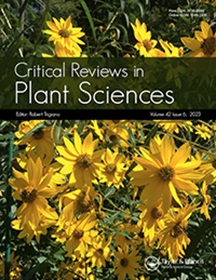Powdery Mildews on Lactuca Species – A Complex View of Host-Pathogen Interactions
IF 6
2区 生物学
Q1 PLANT SCIENCES
引用次数: 5
Abstract
Abstract The present work summarizes important new information and results focused on powdery mildew occurring on the genus Lactuca from a growing body, including long-term research. This plant genus is host to at least three biologically and ecologically different genera of powdery mildew: Golovinomyces (U. Braun) Heluta, Podosphaera Kunze, and Leveillula G. Arnaud. The taxonomy, distribution, morphology, and biology of Golovinomyces bolayi, Podosphaera xanthii, Leveillula lactucae-serriolae, and L. lactucarum are also discussed, along with the threat they pose to Lactuca spp., as well as methods of control. A deeper understanding has only been obtained in the Lactuca spp. – Golovinomyces bolayi pathosystem. The results of 20 years of study into the occurrence of G. bolayi in wild L. serriola populations in the Czech Republic found that the percentage of L. serriola populations infected by G. bolayi (disease incidence) varied considerably between 29 and 75.2% over the reporting period. Although this powdery mildew appears to prefer warmer temperatures (about 20 °C) and lower precipitation, it is hard to discern a direct relationship between meteorological data and disease occurrence. Study of the pathogenic variability of G. bolayi isolates from the Czech Republic between 2008 and 2017 (on a unified and stable differential set of 13 genotypes of genus Lactuca spp.) confirmed that G. bolayi isolates represented different combinations of reaction patterns on the Lactuca spp. differential set. However, isolates virulent on all 13 genotypes (i.e. super-race) were recorded very sporadically. Moving forward, studies of the mechanisms and genetics of resistance are greatly needed.乳酸菌上的粉末状霉菌——宿主与病原体相互作用的复杂视角
摘要本工作从生长体中总结了关于乳酸菌属发生白粉菌的重要新信息和结果,包括长期的研究。该植物属至少有三个生物学和生态学上不同的白粉菌属:Golovingomyces(U.Braun)Heluta、Podosphaera Kunze和Leveilula G.Arnaud。文中还讨论了博拉伊歌洛温酵母、黄球藻、serriolae乳球藻和乳球藻的分类、分布、形态和生物学,以及它们对乳球藻属的威胁和防治方法。只有在乳酸菌属-博拉伊哥洛温酵母的病理系统中才有了更深入的了解。对捷克共和国野生斑潜蝇种群中斑潜蝇发生情况进行了20年的研究,结果发现,在报告所述期间,斑潜蝇感染斑潜蝇的比例(发病率)在29%至75.2%之间有很大差异。尽管这种白粉菌似乎更喜欢温暖的温度(大约20 °C)和较低的降水量,很难辨别气象数据与疾病发生之间的直接关系。2008年至2017年间,对捷克共和国的G.bolayi分离株的致病性变异性的研究(基于13种乳酸菌属基因型的统一稳定的差异集)证实,G.bolayy分离株在乳酸菌属差异集上表现出不同的反应模式组合。然而,对所有13种基因型(即超级小种)都有毒力的分离株是零星记录的。今后,迫切需要对抗性的机制和遗传学进行研究。
本文章由计算机程序翻译,如有差异,请以英文原文为准。
求助全文
约1分钟内获得全文
求助全文
来源期刊
CiteScore
12.90
自引率
1.40%
发文量
15
审稿时长
>12 weeks
期刊介绍:
Critical Reviews in Plant Sciences focuses on presenting in-depth and up-to-date reviews of timely and/or cutting-edge subjects in the broad discipline of plant science, ranging from molecular biology/biochemistry through the areas of cell biology, plant pathology and physiology, genetics, classical botany, and ecology, to practical agricultural applications. Articles in the journal provide an up-to-date literature base for researchers and students, pointing the way towards future research needs. The journal is also a significant source of credible, objective information to aid decision makers at all levels.

 求助内容:
求助内容: 应助结果提醒方式:
应助结果提醒方式:


